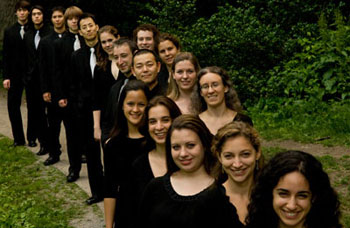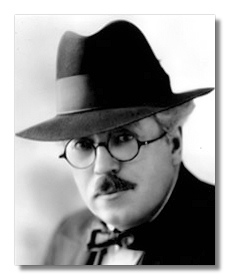Fuse Concert Review: A Dazzling Performance From A Far Cry
What continually impresses about A Far Cry is their discipline, ability to keep complicated rubato under complete control, well-modulated dynamics, beauty of sound, and really interesting programming.
A Far Cry. At the Rockport Music Festival, Rockport, MA, June 14.
By Susan Miron.
I loved A Far Cry, the hugely successful, self-conducted, Boston-based chamber orchestra, from the first time I heard them in the (pre-renovations) Isabella Stewart Gardner Museum. The 17 young players impress with their virtuosity, musical intelligence, and ability to play complex music from several centuries extraordinarily well. Formed in 2007, they are the in-house Chamber Orchestra in Residence at the Gardner Museum, and partners at New England Conservatory in training young musicians.
The violinists on Thursday played, most of the time, in two rows, across from the four excellent violists. The three terrific cellists were the only seated players, behind which two basses stood. Violinists (and violists) really do, I think, sound better standing, and judging by their constantly shifting positions—each piece had a different concertmaster and principal string player—these are players who could, and do, perform comfortably in any position in this chamber orchestra. What continually impresses about this group is their discipline, ability to keep complicated rubato under complete control, well-modulated dynamics, beauty of sound, and really interesting programming. Rotating leadership seems to work like a charm for them.
The Criers opened the sold-out concert with Osvaldo Golijov’s “Tenebrae,” (Darkness), a 14-minute meditation on an ancient evening service of the Christian Church sung during Holy Week. Originally written for the Kronos Quartet in 2000, A Far Cry’s arrangement for string orchestra was greeted with great enthusiasm by the composer when he heard it. “It’s better than the quartet version,” he exclaimed. “The density of the sound is gorgeous. It glows.” Golijov aimed “to write music that would sound as an orbiting spaceship that never touches ground.” It is a piece of great beauty with layers of sadness just below the surface. The Far Cry played it on the radio to commemorate 9/11. I found it mesmerizing. For an achingly lovely performance of this piece, along with a conversation with the composer, check out the video below.
David Deveau, the music director of the Rockport Festival since 1995, is also a terrific pianist, but last year he had to cancel all of his summer appearances at the festival because of hand problems. His appearance on Thursday with A Far Cry was a joyous occasion. He played Mozart’s Piano Concerto #14 in E Flat, K. 449 absolutely beautifully. Mr. Deveau’s playing was both elegant and eloquent—a perfect match for this rarely heard concerto, which features one of Mozart’s most somberly lyrical slow movements. A Far Cry was, as usual, an excellent collaborator. This concerto was the first of 12 Mozart wrote between 1784-1786, and is considered the first of his “mature” concertos. Although it was scored for piano and strings, with optional pairs of horns and oboes, it sounded superb with A Far Cry’s strings. Mr. Deveau received a well-deserved standing ovation.
The next several pieces featured the excellent violinist Andrés Cárdenes, formerly concertmaster of the Pittsburgh Symphony. Antonio Vivaldi’s Concerto in D Major, Opus 4, No. 11 from “La Stravaganza” (Extravagance), from a volume of 12, received a glowing performance from Mr. Cárdenes and A Far Cry’s harpsichord player and principal strings (for that piece). Mr. Cárdenes here had a light quality of sound, but he was never overbalanced by the strings.
Vivaldi was followed by a Vivaldi homage—”Invierno” and “Otoño” (Winter and Autumn) by the celebrated Argentine composer Astor Piazzolla, one of the musical leaders in popularizing the tango. “Invierno” and “Otoño” are two of the four movements from his Quatro Estaciones Porteñas (The Four Seasons of Buenos Aires—porteñas is someone from Buenos Aires) and exist in many formats (I have harp transcriptions of them). This version for string orchestra and violin soloist was arranged by Leonid Desyatnikov and is an homage to Vivaldi’s Four Seasons. (A Far Cry has recorded these pieces in a new arrangement by the bandoneon player Julien Labro.) Mr. Cárdenes played his solo parts with panache and mastery of his instrument. In “Otoño” the cellist (names of principals and the harpsichordist were not in the program, alas) was superb in a piece that threatens to devolve into a cello concerto; the bass player was also excellent. This standing ovation, I think, was for all the players.
Finally, we heard the 23-year-old Benjamin Britten’s “Variations on a theme of Frank Bridge,” Op. 10 (1937), an important piece that doesn’t get heard all that often often. I am glad I heard A Far Cry’s version, because it most likely will never get a better performance. The 10 variations of this piece are intended to illustrate specific qualities of Frank Bridge, Britten’s beloved teacher. Rockport’s program book is a real gem, full of intelligent commentary about the music, with little photos, illustrations, and extra, interesting information placed on the side of the pages. Here is their note about the 10 variations:
According to Britten’s notations, the Adagio was meant to portray Bridge’s integrity, the March his energy, the Romance his charm, the Aria italiana his humor, the Bourée his tradition, the Wiener Walzer his enthusiasm, the Moto perpetuo his vitality, the Funeral March his sympathy, the Chant his reverence, the Fugue his skill, the Finale their mutual affection. Britten wrote brilliantly for strings (he studied viola and wrote important works for it) and he deployed here all the string techniques in his arsenal.
A Far Cry met all the challenges handily. They are doing the festival circuit this summer, along with their first trip to Europe. They deserve whatever fame comes their way because they are simply dazzling.


